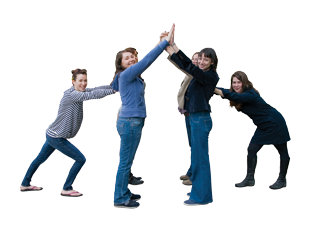
The commands for students shaping a medieval cathedral on the lawns of Kenyon include "Stand up straight" and "Pretend you're a wall."
"We all fall down" is not an option.
Sarah Blick, associate professor of art history, has molded student bodies into Gothic cathedrals for about twelve years. She picked up the idea on the nascent Internet and, with some of her own construction tweaks, has made the exercise a building block in some courses that cover medieval art and architecture.
The flying buttress is among those architectural notions of weight distribution and support that are sometimes easier to demonstrate than imagine. "A lot of innovations and aesthetics come from having to deal with architectural problems," Blick says. "Students are so used to walls standing up, they're not thinking about it."
The first obstacle is asking students to overcome a slight aversion to, well, actually touching one another. "It's not like, 'Everybody hold hands.' It has a purpose and it doesn't last long," she says.
In groups that can top forty, Blick asks students to line up facing one another, with arms raised. Each person's hand connects to the people on both sides and to the person he or she faces, creating the cathedral nave and vaulted ceiling. The facing walls tend to fall back after the hands on one side push against the hands on the other. And that's the idea.
"Actually, the hardest part of the whole deal is getting them to stand up straight," said Blick, a study in cheerful determination. "The most important feeling is when the people who are the nave wall realize that they are going backward. The roof vault pushes out and down."
So the flying buttresses step into action. Students form second lines just behind the first lines, each student-buttress spaced in between and supporting two people, with one hand each in the middle of their backs. They provide the support needed to keep the wall standing against the pressure created by the facing wall.
"I think most of the professors here are always looking for good teaching techniques that can really make things come alive," Blick says. "This one's been consistently good. It's kind of fun."

 Delicious
Delicious Facebook
Facebook StumbleUpon
StumbleUpon Digg
Digg reddit
reddit